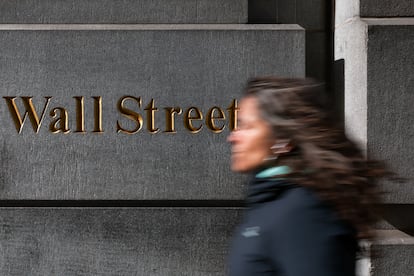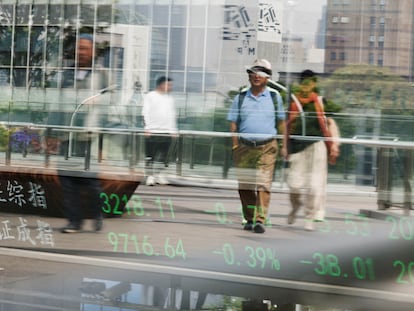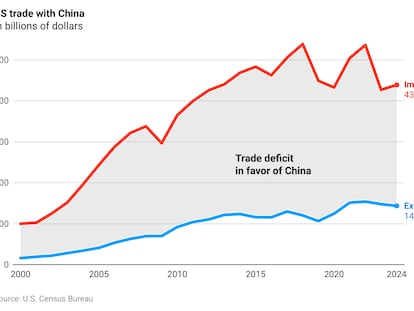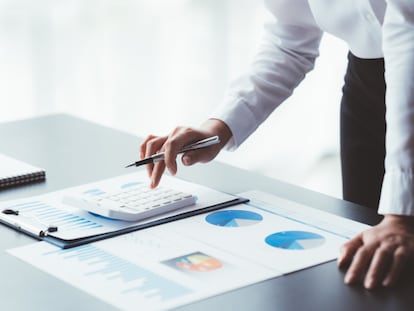Trump 2.0 stock market lessons: The cost of trying to ride the wave of volatility
Investing in the US stock market has yielded significant long-term returns, but these gains are considerably diminished if the investor sells in a panic or in haste

Donald Trump is rattling the nerves and spirits of investors and citizens around the world. His declaration of a trade war has triggered an unprecedented stock market crisis, illustrating how the will of the president of the world’s largest economy can upend the long-standing global economic status quo — without the need for bank failures or actual wars.
The sell-off has been so intense that it has impacted U.S. sovereign debt, a cornerstone for the country’s financing and sustainability. As a result, Trump announced a 90-day pause on tariffs on Wednesday, with the exception of those imposed on China. This news fueled a 9.52% rise in the S&P, the largest since 2008, and a 12.16% jump in the Nasdaq, the second-largest in its history. These were gains missed by those who chose to sell following Trump’s trade war declaration on April 2. In the long-term, those who held steady through the bearish wave saw better returns.
Before announcing a pause on tariffs, Trump warned of a potential stock market rally. He tweeted that it was “a great time to buy.” Whether this was based on privileged information remains to be seen, but for those who missed the rise, there is consolation in the long-term gains the U.S. stock market typically delivers. Many fund managers emphasize that in times of high volatility, it is crucial to avoid making hasty decisions about entering or exiting the market. Fidelity, a U.S. fund manager, reminds investors that missing the five best days — and even the 30 best days — dramatically reduces long-term returns.
Fidelity’s argument is based on evidence — applicable to the S&P but not to all stock market indexes — that equities are the most profitable option over time. The S&P 500 has delivered an annual return of 10.23% over the past 20 years, 13.15% over the last 15 years, and 10.98% since 1970. If an investor had placed money in the S&P 500 at the close of 1992, the total return would have amounted to 2,061%, as of the most recent session this past Monday. However, if the investor had missed the five best days during that period, their gain would have dropped to just 1,265%. Missing the 30 best days would have significantly reduced that return, leaving it at a mere 267%, according to Fidelity’s data.
This lesson holds true for other indexes as well. Since 1993, the DAX has gained 1,181%, but missing the five best days drops that to 682%, and missing the 30 best days cuts it to just 75%. For the French CAC, the cumulative return for long-term investors stands at 899%, but if they missed the five best days, it falls to 522%, and missing the 30 best days reduces it to just 40%.
The bullish aftermath of Trump’s tariff truce has led to daily gains that will go down as some of the best stock market sessions in recent decades, capable of making a significant difference. In Spain’s Ibex, Thursday saw the biggest rise since 2022. However, this euphoria is temporary, and experts advise caution, warning that it’s not yet time to return to the stock market, given the U.S.’s continued determination to apply tariffs — whether to a greater or lesser extent — which will affect growth and inflation. Indeed, losses returned to Wall Street just a day later, and volatility is expected to remain a constant throughout Trump’s second term.
Nonetheless, managers recommend capitalizing on market rallies to take profits and diversify investments. The sharp declines in recent days have been driven by the widespread fear of a recession and by profit-taking after a strong rally in the European stock market during the first quarter. On Wall Street, the downward trend that began earlier in the year has only intensified, working to correct excesses in a market that has enjoyed 15 consecutive years of growth.
Sign up for our weekly newsletter to get more English-language news coverage from EL PAÍS USA Edition
Tu suscripción se está usando en otro dispositivo
¿Quieres añadir otro usuario a tu suscripción?
Si continúas leyendo en este dispositivo, no se podrá leer en el otro.
FlechaTu suscripción se está usando en otro dispositivo y solo puedes acceder a EL PAÍS desde un dispositivo a la vez.
Si quieres compartir tu cuenta, cambia tu suscripción a la modalidad Premium, así podrás añadir otro usuario. Cada uno accederá con su propia cuenta de email, lo que os permitirá personalizar vuestra experiencia en EL PAÍS.
¿Tienes una suscripción de empresa? Accede aquí para contratar más cuentas.
En el caso de no saber quién está usando tu cuenta, te recomendamos cambiar tu contraseña aquí.
Si decides continuar compartiendo tu cuenta, este mensaje se mostrará en tu dispositivo y en el de la otra persona que está usando tu cuenta de forma indefinida, afectando a tu experiencia de lectura. Puedes consultar aquí los términos y condiciones de la suscripción digital.
More information
Archived In
Últimas noticias
ChatGPT fails the test: this is how it endangers the lives of minors
The late consecration of women artists in their 90s
The Florida Keys tourist paradise is besieged by immigration agents: ‘We’ve never seen anything like this’
The latest scam on WhatsApp behind the legal dream: using immigration status as bait
Most viewed
- Families demand repatriation of bodies of Colombians who died in Ukraine: ‘This war is a slaughterhouse for foreigners’
- The low-cost creative revolution: How technology is making art accessible to everyone
- Liset Menéndez de la Prida, neuroscientist: ‘It’s not normal to constantly seek pleasure; it’s important to be bored, to be calm’
- Christian Louboutin: ‘Young people don’t want to be like their parents. And if their parents wear sneakers, they’re going to look for something else’
- ‘El Limones’ and the growing union disguise of Mexican organized crime











































